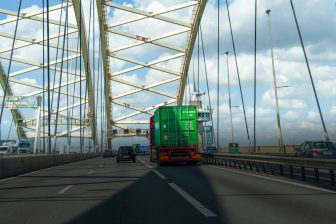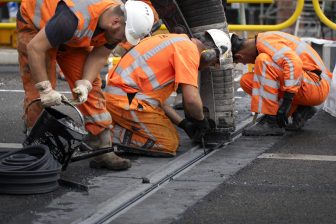
Interview with Christopher Irwin, Vice chair, European Passengers’ Federation (EPF)

The 4th Railway Package was designed to enable rail to grow again. To achieve this single standards and certificates are needed for trains, rolling stock and companies to operate Europe-wide; the functions of managing the tracks and running the trains should be kept seperate and the passenger railwaymarket should be opened to new entrants and services.
1. Is the 4th Railway Package meeting its challenge to enable rail to grow again or are other measures needed?
The Fourth Railway Package was intended to reverse stagnation – and in some cases actual decline – in rail’s share of Europe’s vigorously competitive transport market. By introducing competition to rail itself it aimed to stimulate improved quality and more choice for rail users. Even if enacted in its entirety, it would be some years before rail users would feel its full effects. Some important parts of the Package reflect previous attempts to provide the framework for market opening. These were resisted by some incumbent national operators and their national administrations who were determined to maintain dominance over their domestic networks. The relative failure of this earlier legislation is seen to reflect a failure in political will.
This was particularly the case when it came to encouraging innovation and new entrants to the market. Some of the traditional national railway operators – including those that have played a key part in the successful opening of the rail markets in other EU countries like Great Britain, where rail has seen enormous growth and vastly improved services – have proved resolute in resisting the opening of their home markets. They have encouraged their member states to resist that part of the Fourth Railway Package designed to foster market opening – the part of the Package known as the Governance Pillar. This Pillar was designed to protect new entrants against the possibility of discriminatory action by infrastructure managers and their associated train operating companies and to ensure that any services provided under public service contracts are subject to the market disciplines of open competitive tendering.
The other part of the Package, the so-called Technical Pillar, has generally received a much more positive response from equipment manufacturers and operators alike. If realised it should streamline the process of setting technical standards and obtaining regulatory approvals for the introduction of new, modern equipment throughout Europe. This is expected to deliver hundreds of millions of savings. In the end it will be Europe’s tax-payers, who currently contribute around €50 billion to funding our railways and, hopefully, rail’s users who will benefit from reduced costs. This part of the package won the support of the European Parliament in February and the political agreement of Member States in early June.
But there is a risk that the Technical Pillar could be abandoned should the Governance Pillar fail to win support from a sufficient number of Member States. Both the European Commission and the Parliament’s Transport Committee have made it clear that the Fourth Package must be accepted as a whole.
It is hard to under-estimate the likely impact on Europe’s rail sector of the Commission being forced to abandon its plans. Rail was a centre-piece of the Commission’s last Transport White Paper. This set the goal of rail having a majority share by 2050 of the medium-distance market. This is a multi-fold increase in rail’s present share of around 10%. It was accepted that rail would be the main beneficiary of the EU’s €26 billion Connecting Europe Facility which is designed to lever vastly greater sums of private finance into Europe’s rail infrastructure. If the Fourth Railway Package the policy equivalent of solitary confinement while vast sums are poured into the electrification of Europe’s auto-routes and the roll-out of intelligent traffic systems and automated road vehicles. Rail is at an historic turning point.
2. Passengers still meet barriers on their international journey. Can you give examples?
With honourable exceptions on a handful of high-speed international routes such as those operated by Thalys, Railjet and Eurostar services, national rail companies have overseen a massive decline in cross-border rail connections over the last quarter century. It is increasingly difficult to make through, cross-border journeys by ‘classic’ trains. This contrasts with the investment in Europe’s auto-route network. The competitive disadvantage of rail has been accentuated by the success of Europe’s low-cost airlines, themselves the product of the type of market opening at the end of the last century that is now so vigorously resisted by key national rail operators.
3. How can the barriers to international traveling be removed?
We need to ensure that new operators seize the opportunities foreshadowed by the Technical Pillar of the Fourth Railway Package to streamline the process of setting technical standards and obtaining regulatory approvals for the introduction of new, modern equipment throughout Europe. The European Railway Agency, which I currently chair, has a key part to play here. Governments also need to give vigorous thought to ways of making land security controls less burdensome, particularly for those travelling between the Schengen countries and other parts of the EU. It is clearly perverse to be surrendering the time-benefits of investment in high-speed services for want of a more innovative approach to managing the challenges posed by the politics of immigration control and counter-terrorism. But perhaps the greatest challenge is to persuade train operators and their regulators to think about the potential of international markets. There are signs that this is happening with the freight sector, assisted by the EU’s development of freight corridors and the emergence of vigorous new players whether DB Schenker or the growing number of smaller independent operators, a number of which are in evidence in the Netherlands. We shouldn’t have to wait for EU legislation that obliges national regulators to cooperate with one another or which guides infrastructure managers into establishing dedicated international corridors under the control of Brussels-authorised infrastructure managers. There is a market opportunity to be seized: the railways need to show commercial initiative.
4. Consumer satisfaction in train is low compared to local transport and airlines. How to improve this?
The European Commission’s annual consumer services’ scoreboard shows that railway undertakings are ranked by the public down near the bottom of the list for consumer satisfaction – rubbing shoulders with real estate agents and even worse than banks. By contrast, air carriers are near the top of the list. While this ranking probably reflects in part the dissatisfaction of many daily commuters with their lot it is also clear that, compared with most of Europe’s airlines, rail operators pay relatively little attention to the needs and aspirations of their potential customers. Passengers don’t feel properly valued. We know that the principal driver of dissatisfaction is the way that railways frequently mismanage things when there are problems on the line – passengers left uninformed.
For too many of us rail is a ‘distress purchase’, something done when people feel there is no other choice. The only way of achieving massive modal shift to rail is either to introduce the type of command economy that went out with the Soviet Union or to work to make rail the mode of first preference. That requires inspired operators who are dedicated to putting the needs and aspirations of their potential customers first. Passenger satisfaction is an excellent measure of policy success. The railway sector has a long way to go but – as has been demonstrated by the British open-access operators (now owned by Deutsche Bahn) – it is possible for a railway undertaking to achieve 95% passenger satisfaction scores according to the national surveys undertaken by the country’s official passenger watchdog.
U las zojuist één van de gratis premium artikelen
Onbeperkt lezen? Profiteer nu van de introductieaanbieding voor € 10,- per maand.
Bent u al abonnee?



